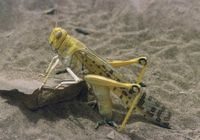
Photo from wikipedia
Preventive control of desert locusts is based on monitoring recession areas to detect outbreaks. Remote sensing has been increasingly used in the preventive control strategy. Soil moisture is a major… Click to show full abstract
Preventive control of desert locusts is based on monitoring recession areas to detect outbreaks. Remote sensing has been increasingly used in the preventive control strategy. Soil moisture is a major ecological driver of desert locust populations but is still missing in the current imagery toolkit for preventive management. By means of statistical analyses, combining field observations of locust presence/absence and soil moisture estimates at 1 km resolution from a disaggregation algorithm, we assess the potential of soil moisture to help preventive management of desert locust. We observe that a soil moisture dynamics increase of above 0.09 cm3/cm3 for 20 days followed by a decrease of soil moisture may increase the chance to observe locusts 70 days later. We estimate the gains in early warning timing compared to using imagery from vegetation to be 3 weeks. We demonstrate that forecasting errors may be reduced by the combination of several types of indicators such as soil moisture and vegetation index in a common statistical model forecasting locust presence. Policy implications. Soil moisture estimates at 1 km resolution should be used to plan desert locust surveys in preventive management. When soil moisture increases in a dry area of potential habitat for the desert locust, field surveys should be conducted two months later to evaluate the need of further preventive actions. Remote sensing estimates of soil moisture could also be used for other applications of integrated pest management.
Journal Title: Journal of Applied Ecology
Year Published: 2019
Link to full text (if available)
Share on Social Media: Sign Up to like & get
recommendations!